It looks like you're using an Ad Blocker.
Please white-list or disable AboveTopSecret.com in your ad-blocking tool.
Thank you.
Some features of ATS will be disabled while you continue to use an ad-blocker.
share:
In recent years Gobustan Petroglyphss showing ships dated to between 12,000 to 7,000 years old found in
the mountains of the Southern Trans-Caucasus that border the Caspian sea have attracted interest, it's been considered that this could form a basis
for similar motifs in early bronze age Scandinavian culture, such as the ship petroglyphs of
Tanum Sweden, which seems likely to me, that a branch of this culture had
navigated up the Volga into Northern Europe.
What i want to look at here though is a later branch of this culture establishing Dynastic Egypt...
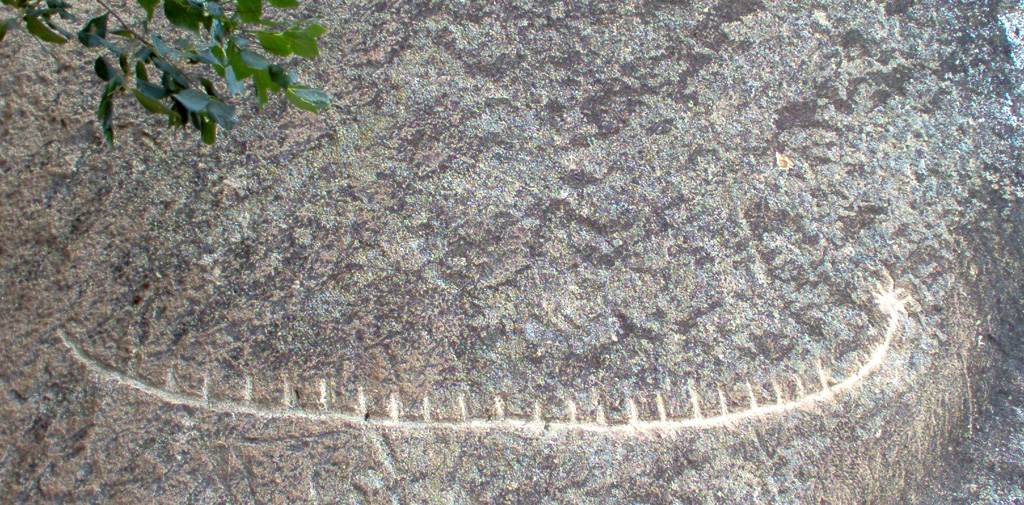
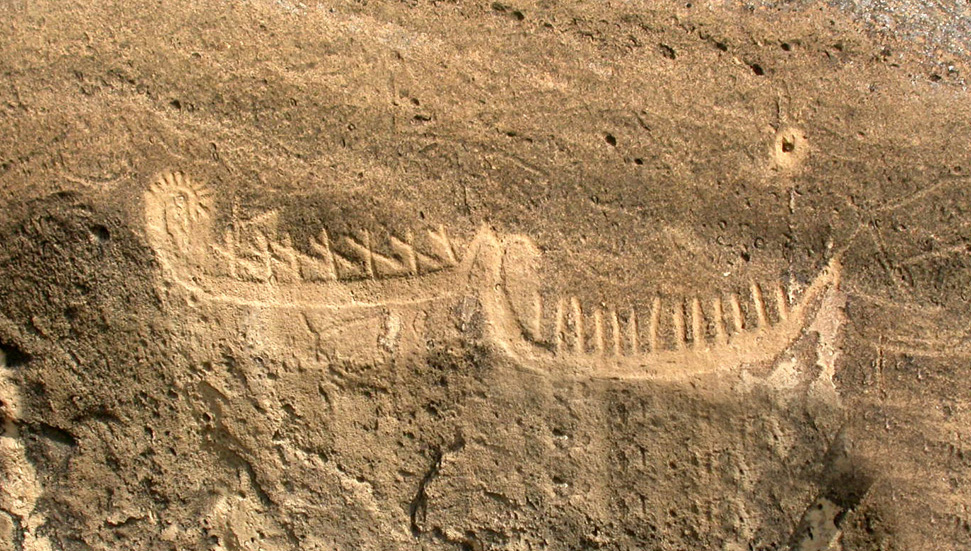
The Gobustan petroglyphs indicate longship vessels designed for the Caspian sea, previously i have looked at the expansion from that region of the highland pastoralist and casting cultures which were interested in developing the resources and trading connections through the highlands and were an important factor in supplying early civilizations such as the Sumerian with ores and expertise when it came to fabricating tools and weapons, as well as luxury items.
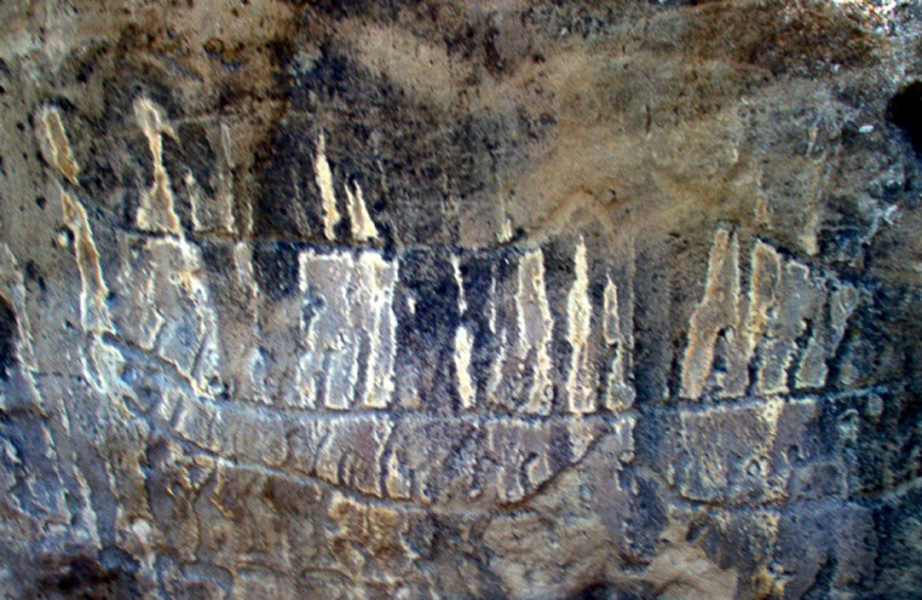
The expansion of interest of these highlanders or Hurrians was then generally overland into lowland agricultural regions, but in considering that their interests had extended as far as Pre-Dynastic Egypt with regards to The Followers of Horus navigation around the Arabian Peninsula and across the Red sea had to be accounted for, their capacity in sailing and ship building.

Petrie had considered that Dynastic Egypt was founded by arrivals from the Red Sea, the only seemingly viable group for this the Mesoptamians, but he wasn't aware of the extent to which the Hurrians were developing resources and expanding areas of interest working in conjunction with Mesoptamia and Indus valley civilization, so the group that seems more likely to me to have influenced Naqada II culture had it's origins on the shores of the Caspian sea, and the Eastern Desert Petroglyphs show this correspondence, so examples of these;
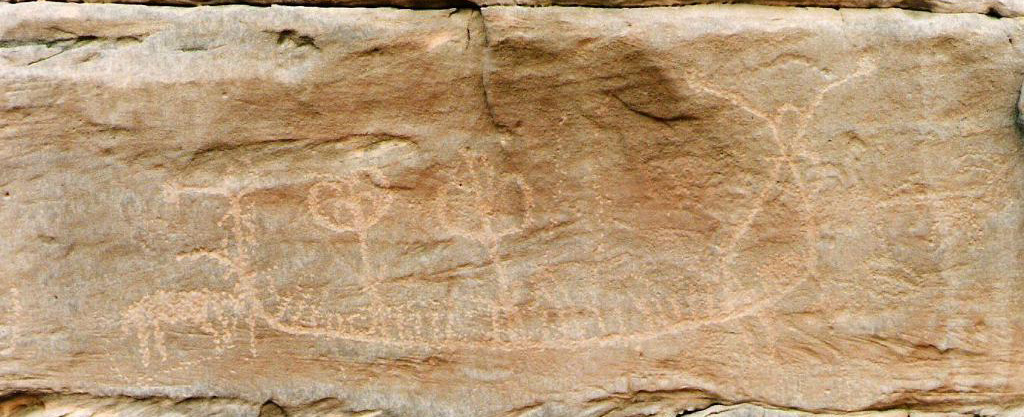
To get a sense of scale of the longships involved here the artist has kindly also represented an elephant to establish such;
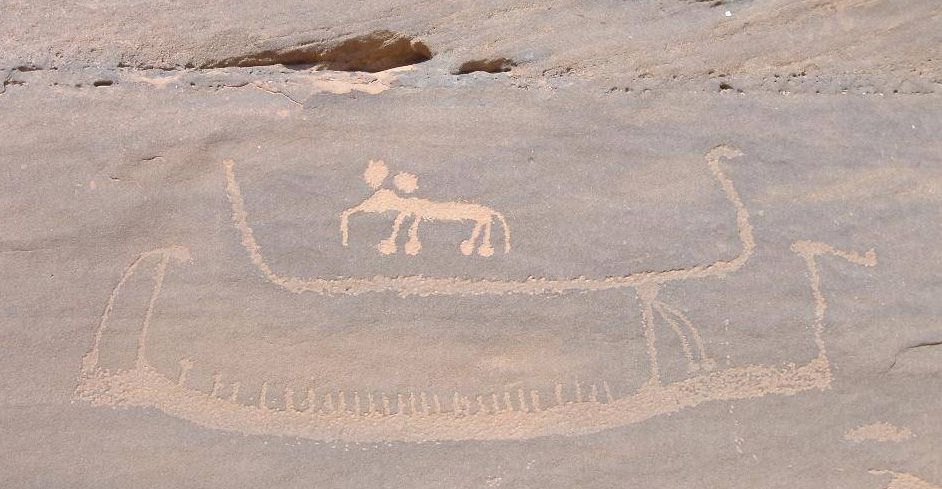
In another interesting example it can be seen that the ship is being dragged overland by figures which are miniscule in comparison;
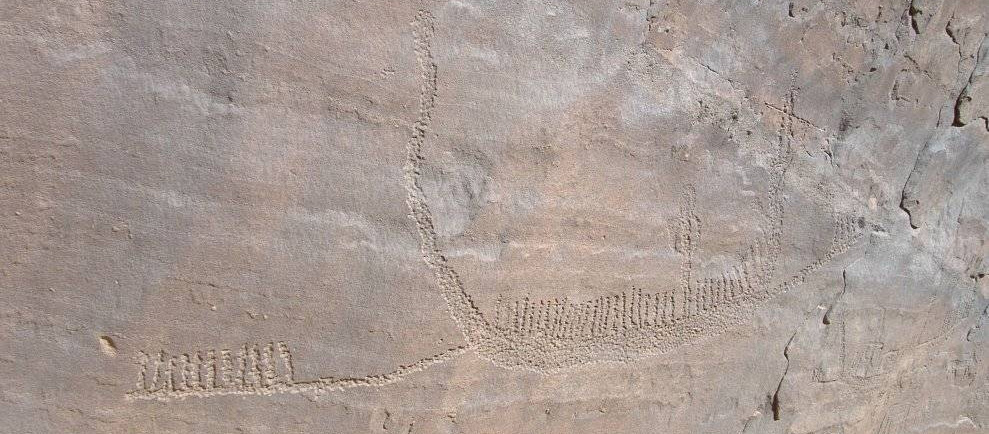
The figures, likely Deities, raising their arms to describe a circle above their heads find correspondence in Gobustan petroglyphs.
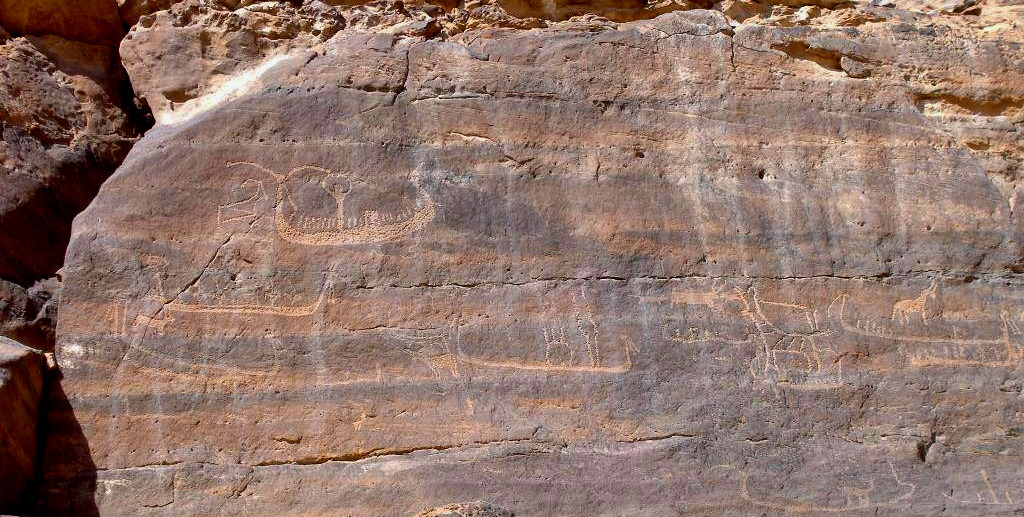
So it needs to be considered what is the overall context for these Eastern Desert tableau close to the Red Sea, that in several instances show ships being dragged overland, it has to be said there are often lots of animals involved and a scenario almost as epic as Noah's ark, the Hurrians were pastoralists and the import and export of livestock could have been a factor, domesticated horses perhaps also as they are seen ridden.

Overall the sense that i get is that the petroglyphs commemorate and celebrate the arrival of this sea faring group, and this in fact is further seen at Abydos were a later tomb shows a Tableau of Egyptian boatsrelating to the earlier ship burial tradition of Abydos, both of which involved large quantities of beer vessels
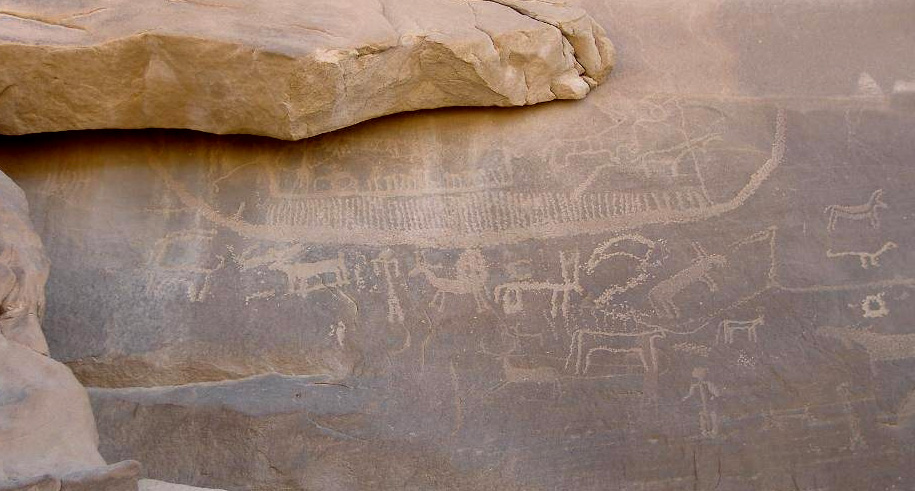
The examples of early Dynastic longships discovered at Abydos indicate these were up to 80 feet long;
You will find several types of boat represented on the petroglyphs, some small frond or reed boats ideal for sailing on a wadi, later examples of Nile sailing ships, but the longboats are quite distinct and were constructed of wood, they don't however go on to be the general type of ship seen in Egypt, that the designs of lower Egypt predominate.
In recent times political correctness has sought to marginalize any external influence with regards to the development of Dynastic Egypt, but that of course was just fake archaeology...

What i want to look at here though is a later branch of this culture establishing Dynastic Egypt...

Images abound in Gobustan implying a reverence for the sun, the sky, and fire: solar chariots and boats, the sun depicted in the form of a swastika, goats with sun-shaped horns, and human forms raising their arms above their heads to form perfect circles. Images of the sun are associated with fire and the hearth, and hearths are sometimes located near solar imagery.

The Gobustan petroglyphs indicate longship vessels designed for the Caspian sea, previously i have looked at the expansion from that region of the highland pastoralist and casting cultures which were interested in developing the resources and trading connections through the highlands and were an important factor in supplying early civilizations such as the Sumerian with ores and expertise when it came to fabricating tools and weapons, as well as luxury items.

The expansion of interest of these highlanders or Hurrians was then generally overland into lowland agricultural regions, but in considering that their interests had extended as far as Pre-Dynastic Egypt with regards to The Followers of Horus navigation around the Arabian Peninsula and across the Red sea had to be accounted for, their capacity in sailing and ship building.

Petrie had considered that Dynastic Egypt was founded by arrivals from the Red Sea, the only seemingly viable group for this the Mesoptamians, but he wasn't aware of the extent to which the Hurrians were developing resources and expanding areas of interest working in conjunction with Mesoptamia and Indus valley civilization, so the group that seems more likely to me to have influenced Naqada II culture had it's origins on the shores of the Caspian sea, and the Eastern Desert Petroglyphs show this correspondence, so examples of these;

To get a sense of scale of the longships involved here the artist has kindly also represented an elephant to establish such;

In another interesting example it can be seen that the ship is being dragged overland by figures which are miniscule in comparison;

The figures, likely Deities, raising their arms to describe a circle above their heads find correspondence in Gobustan petroglyphs.

So it needs to be considered what is the overall context for these Eastern Desert tableau close to the Red Sea, that in several instances show ships being dragged overland, it has to be said there are often lots of animals involved and a scenario almost as epic as Noah's ark, the Hurrians were pastoralists and the import and export of livestock could have been a factor, domesticated horses perhaps also as they are seen ridden.

Overall the sense that i get is that the petroglyphs commemorate and celebrate the arrival of this sea faring group, and this in fact is further seen at Abydos were a later tomb shows a Tableau of Egyptian boatsrelating to the earlier ship burial tradition of Abydos, both of which involved large quantities of beer vessels
More than 120 images of ancient Egyptian boats have been discovered adorning the inside of a building in Abydos, Egypt. The building dates back more than 3,800 years and was built near the tomb of pharaoh Senwosret III, archaeologists reported.
Near the entranceway of the building — whose interior is about 68 feet by 13 feet — archaeologists discovered more than 145 pottery vessels, many of which are buried with their necks facing toward the building's entrance. "The vessels are necked, liquid-storage jars, usually termed 'beer jars'

The examples of early Dynastic longships discovered at Abydos indicate these were up to 80 feet long;
..early excavation of a ten-foot portion of one of the wooden hulls has already yielded surprising results: the archaeologists now believe the boats were not models, as many mortuary-associated objects could be, but viable vessels which could accommodate as many as 30 rowers. According to boat expert Cheryl Ward, the mode of construction is unique among surviving ancient Egyptian boats.
About 75 feet in length and seven to ten feet in width at the widest point, these boats are only about two feet deep, with narrowing prows and sterns.
Abydos Royal Boats
You will find several types of boat represented on the petroglyphs, some small frond or reed boats ideal for sailing on a wadi, later examples of Nile sailing ships, but the longboats are quite distinct and were constructed of wood, they don't however go on to be the general type of ship seen in Egypt, that the designs of lower Egypt predominate.
In recent times political correctness has sought to marginalize any external influence with regards to the development of Dynastic Egypt, but that of course was just fake archaeology...

edit on Kam13125vAmerica/ChicagoThursday2631 by Kantzveldt because: (no reason given)
a reply to: Kantzveldt
Threads like this are why I found ATS in the first place.
Wish I could give more then a S&F!
So here is some applause for what its worth.

Researching this now, THANK YOU.
Threads like this are why I found ATS in the first place.
Wish I could give more then a S&F!
So here is some applause for what its worth.

Researching this now, THANK YOU.
I first came across the idea of Egypt being invaded from the red sea via the canyons (wetter in those day, he guessed) connecting it with the Nile, in
the works of David Rohl. He believed the invasion came from Mesopotamia, but that part was far from certain, given the evidence he presented.
a reply to: ignorant_ape
Shouldn't need to be considered if they're commemorating arrival on the Red Sea coast and dragging the boats across the Eastern Desert, there's also the fact that the construction methodology of the Abydos ship burials wasn't the norm for Egypt, the longship illustrations are relatively localized to the Eastern desert.
There is also the consideration that Naqada II which i would date this too began importing materials such as cobalt, tin, silver and lapis lazuli that were previously unknown to them and underwent marked advancement, the only source for those materials was through Hurrian connections as they were from Iran and beyond.
Shouldn't need to be considered if they're commemorating arrival on the Red Sea coast and dragging the boats across the Eastern Desert, there's also the fact that the construction methodology of the Abydos ship burials wasn't the norm for Egypt, the longship illustrations are relatively localized to the Eastern desert.
There is also the consideration that Naqada II which i would date this too began importing materials such as cobalt, tin, silver and lapis lazuli that were previously unknown to them and underwent marked advancement, the only source for those materials was through Hurrian connections as they were from Iran and beyond.
First... you've conflated several petroglyphs from different places and times. Some are palimpsests - material done one time (the "elephant in a
boat") with material from another time written near or on top of them. In this case, the patina shows the much elephant is newer than the boat.
Secondly, you are dealing with many artists and no standard formal artwork expression. If you and I draw boats, they will tend to look like boats all across the world, even from cultures that have no contact with us.
If you want to prove similarity, you have to show that the actual physical boats were constructed in the same way... cut in the same way, framed in the same way, and have the planks attached in the same way and have the same dimensions and are using the same (or similar) tools.
Viking longships (which are not the first ships from that area) are klinker construction with iron rivets
In contrast, Egyptian ships were mortise and tenon and the planks were sewn together
So, no. Egyptians didn't learn from Vikings (who came to the area around the time of the Crusades) or anyone else from that area, nor did the Vikings learn from the Egyptians.
Secondly, you are dealing with many artists and no standard formal artwork expression. If you and I draw boats, they will tend to look like boats all across the world, even from cultures that have no contact with us.
If you want to prove similarity, you have to show that the actual physical boats were constructed in the same way... cut in the same way, framed in the same way, and have the planks attached in the same way and have the same dimensions and are using the same (or similar) tools.
Viking longships (which are not the first ships from that area) are klinker construction with iron rivets
In contrast, Egyptian ships were mortise and tenon and the planks were sewn together
So, no. Egyptians didn't learn from Vikings (who came to the area around the time of the Crusades) or anyone else from that area, nor did the Vikings learn from the Egyptians.
originally posted by: Kantzveldt
a reply to: ignorant_ape
Shouldn't need to be considered if they're commemorating arrival on the Red Sea coast and dragging the boats across the Eastern Desert,...
Depending on the age of the petroglyphs, it's more likely they're depicting scenes such as are found in the tomb of Seti I, where demigods and spirits are pulling the solar boat through the Underworld.
a reply to: Byrd
The additional elephant is just funny, but in terms of the various styles of boats depicted over different periods they're pretty much got that nailed if you read the descriptions on the website, the longships are Naqada II, it's not just the boats themselves which show correspondence with Gobustan petroglyphs, but associated motifs such as the large figures with arms raised to describe a circle and solar motifs on the prow, the whole solar barque thing is first evidenced in the Trans Caucasus region.
To show physical similarities in construction methodology you'd need actual examples from the Caspian sea and none survive, i don't think you can compare to Viking iron age technology because they made great advances in craft skills, but the bronze age ship Petroglyphs show similar style to those of Gobustan and many shared motifs, i'm hardly suggesting the vikings went to Egypt...
The additional elephant is just funny, but in terms of the various styles of boats depicted over different periods they're pretty much got that nailed if you read the descriptions on the website, the longships are Naqada II, it's not just the boats themselves which show correspondence with Gobustan petroglyphs, but associated motifs such as the large figures with arms raised to describe a circle and solar motifs on the prow, the whole solar barque thing is first evidenced in the Trans Caucasus region.
To show physical similarities in construction methodology you'd need actual examples from the Caspian sea and none survive, i don't think you can compare to Viking iron age technology because they made great advances in craft skills, but the bronze age ship Petroglyphs show similar style to those of Gobustan and many shared motifs, i'm hardly suggesting the vikings went to Egypt...
You guys had a chance to see this national geographic stuff coming up? I dunno exactly whats the deal with it all but I would like to know.
www.youtube.com... National Geographic Atlantis rising new thing.
www.youtube.com... National Geographic Atlantis rising new thing.
originally posted by: stabstab
You guys had a chance to see this national geographic stuff coming up? I dunno exactly whats the deal with it all but I would like to know.
www.youtube.com... National Geographic Atlantis rising new thing.
I see the History Channel has prompted NatGeo to sell out as well.
Harte
a reply to: Kantzveldt
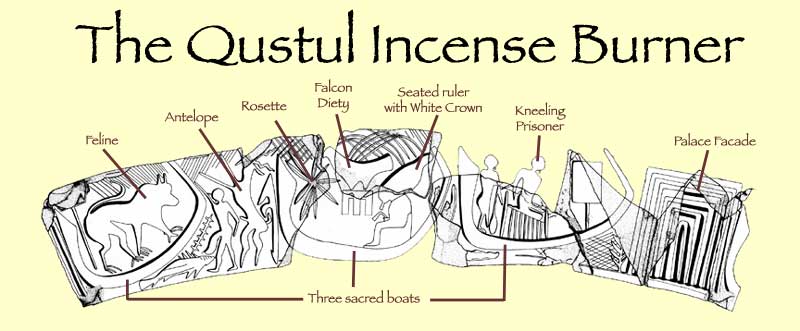
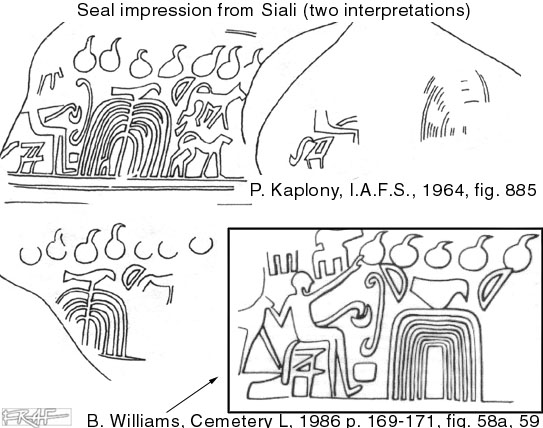
Ta-Seti an early "Nubian" state and the first organized state on the Nile, why am I showing you this, because it's not just the ships, but the Pharaonic paraphernalia, if you can find all those examples in place in the Caucasus/ Black sea region then ..ok but I seriously doubt that, however there may have been a case for an attempted invasion that was thwarted, this came in the form of the Gabrel Arak knife
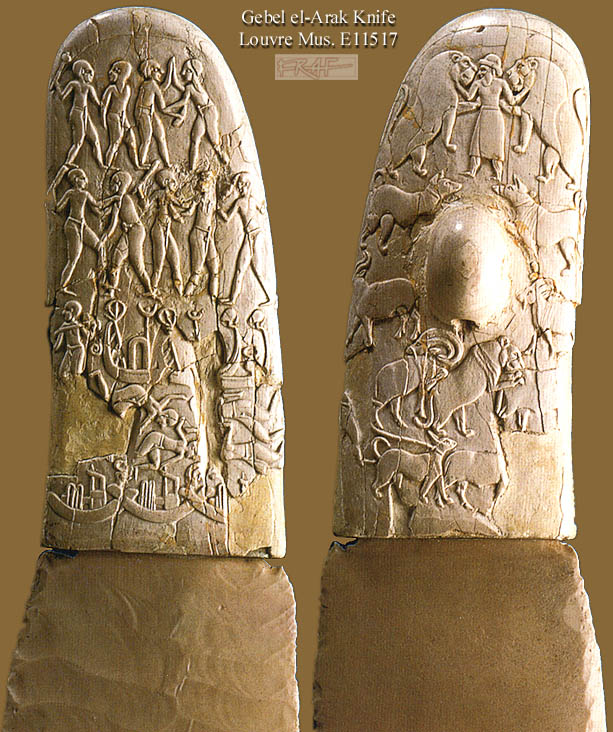
Gebel el Arak Knife with the seemly Mesopotamian motif

Now Byrd is not into 100 yrs old interpretation even if it came from the founders and that science has progressed since then, and I agree to an extent, but at this point I am unaware of any new information concerning the knive itself and the interpretation of it.
But info on the elites at Abydos is that they physically plotted very similar to Ta-Nahasi royals than they do later kemitians and the Black topped pottery indicate that it was at-least partially Ta-Nahasi settlement .


3800-3100 B.C. Qustul: The oldest tombs of a pharaonic type are found in Nubia (Kingdom of Qustul), and these thirty-three A-Group tombs appear in Nubia before the dynastic period. Cemetery L at Qustul, which is a small cemetery containing unusually large and wealthy tombs of A-Group. It was in one of these graves, “L-24” coded by the excavators, that the mysterious incense burner came to light. An incense burner with figures and pictographs gouged deep into the clay. This censer had been found, not in Egypt, but nearly 200 miles deep in Nubia. The inscription showed three ships sailing in procession. The three ships were sailing toward the royal palace. One of the ships carried a lion – perhaps a deity. The central boat carries the king, sitting and equipped with long robe, flail and White Crown. All motifs that would later become symbols of Pharaonic rule in Egypt. This piece had been made no later than 3400 B.C. At that early date, there were not supposed to have been any such things as pharaohs or pharaohs’ palaces.
originalpeople.org...
Ta-Seti an early "Nubian" state and the first organized state on the Nile, why am I showing you this, because it's not just the ships, but the Pharaonic paraphernalia, if you can find all those examples in place in the Caucasus/ Black sea region then ..ok but I seriously doubt that, however there may have been a case for an attempted invasion that was thwarted, this came in the form of the Gabrel Arak knife

Gebel el Arak Knife with the seemly Mesopotamian motif

Gebel el-Arak Knife Pre-historic Egypt, Naqada II (3500-3100 B.C.) Petrie, W.M. Flinders. The Making of Egypt, London. New York, Sheldon Press; Macmillan, pp. 65-66, 1939. Petrie famously known as "The Father of Pre-history". Chapter VII. The Dynastic Conquest Conflict of Races We now have to view as a whole the tumultuous age of dynastic invasion. For some centuries we may see large movements going on, threats from the south and east, and influences from other quarters--one of the great ages of unrest and admixture like the ages of the XIII-XVIIth or XXIIIrd-XXVth dynasties. This troubled time occupied the Semainean age. For a demonstration of the invasion by the dynastic race, one of the greatest events in the history of Egypt, we turn to a single sculpture in ivory, the knife handle from Gebel el-Arak, probably presented to some great chief. The flint blade of the knife was a fine example of parallel flaking. The ivory handle is carved in relief on both sides. On the top of the first side is shown a combat between short-haired men with bullet heads and long-haired men. The bullet heads, like the followers of Narmer, are in all cases getting the better.
Both parties are unclothed, but wear a waist cord to hold up a dagger sheath. The invaders only are armed, using a truncheon. In the lower scene are two lines of ships, and drowned men lying in the sea between them. The upper line is of vessels with high prow and stern, the lower has vessels with cabins like the Egyptian. This is Egyptian history what the Bayeux tapestry is to English history, a national monument of conquest. Happily this is not the only representation of these opposing people, but they are shown also on the one painted tomb at Hierakonpolis. There are also combats of black men overcoming red men.
Source of the Conquerors Adding to the history, there is on the other side of the knife handle a figure of a hero or divinity subduing two lions. Such a group is widely spread, anciently, with lions in Elam, Mesoptamia and Greece; tigers in the Harappa of India; winged bulls or horses in Assyria; ibex in Arabia and deer in Italy; wolves at Athens; swans in Greece. For various animals we see that the idea is not the restraint of violence, but the assumption of power over all Nature, however untamable. Such then is the purpose of this group, and the source of it is a cold country, for the hero has a thick coat and cap, and the lions have thick hair under the whole body as a protection in snow. It must be from mountainous Elam and not from the plains of Mesopotamia that the figures come. The two beautiful figures of dogs belong to the Babylonian myth of Etana on the flying eagle, with two dogs looking up after it. Below these are exquisitely spirited figures of animals, the connection of which we cannot realize in the broken connection. Here is an historic monument of the highest value, but badly wreaked by the Government policy of seizing discoveries.
In a free system of rewards, the tomb where this lay would have comes under official care, all collateral objects would have been preserved, and every fragment of such an ivory could be recovered by sifting. But this object was never known officially till in the hands of the dealer. The ships on the ivory knife handle are distinguished by having an animal head on the prow, probably as a figurehead. These are the bull's head and the oryx head, and they possibly signify the names of the vessels. Below is the black ship at Hierakonpolis, belonging to the black men who are shown as conquering the red men; and the other ship of these conquering invaders on the knife handle, with the similar high prow and round-topped cabin. The subjects of the invasion and conquest carved on this knife handle, and depicted with such vigour . . . . serve to clear away the distorted view of supposing all the history to have been a smooth uniform development of a single people. - W.M. Flinders Petrie
www.newsnfo.co.uk...
Now Byrd is not into 100 yrs old interpretation even if it came from the founders and that science has progressed since then, and I agree to an extent, but at this point I am unaware of any new information concerning the knive itself and the interpretation of it.
But info on the elites at Abydos is that they physically plotted very similar to Ta-Nahasi royals than they do later kemitians and the Black topped pottery indicate that it was at-least partially Ta-Nahasi settlement .
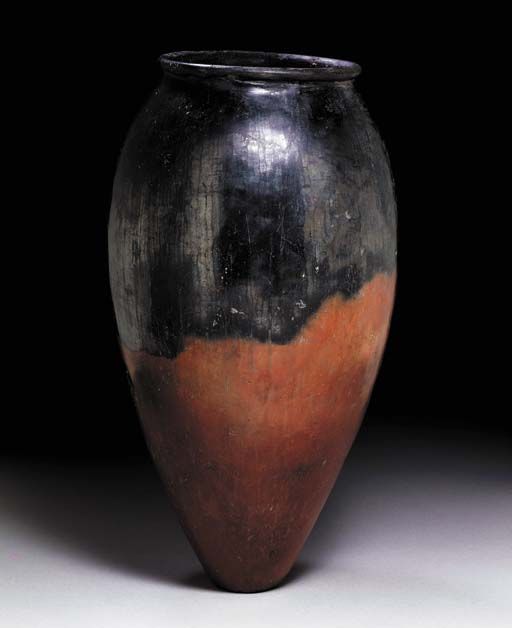
The distinctive black top was produced during the firing process, the precise nature of which is still a source of considerable debate.5 Recent research suggests that it was probably made during a single firing.6 The origin of the ware is found in Badarian black-topped red and brown bowls, a tradition with roots in the Western Oases and the ancient Sudan.7 Early Naqada I shapes were predominantly open jars and bowls of varying heights; in the later part of Naqada I and early Naqada II, closed vessels in globular and ovoid shapes appeared.8 Isolated examples exist in Naqada III, whether these represent genuinely later types or pots gathered from earlier tombs requires further study.9 Black-topped ware was evidently much admired, with Nile Valley 'imports' and/or regional variations in local shapes and clays found in Predynastic deposits at the Dakhleh Oasis,10 Nubia,' Buto,12 Maadi,13 and possibly Southern Palestine.
www.academia.edu...
Dynasty 0
What ever the case an invasion or a raid, it seems to me like the invaders got their noses blooded and leave, or was captured and bounded, because there is nothing in the way of Mesopotamian culture especially the elite to suggest that they carried the day, and long ships with animal prows were a feature across Africa, these ships can carry up to 100 sailors deep and three across, some were outfitted with poop decks they carried baggage for soldiers and ferried horses across wide rivers and lakes.
a reply to: Spider879
There really isn't that much to differentiate the more Southern Ta-Seti culture from that of Naqada I, they both owed their origins to the Neolithic expansion into Egypt that had begun in Anatolia.
I think it's true that Petrie was thinking in terms of invasions, one people displacing another, but i'm not, more in terms of a group looking to find and develop resources and establish trade connections based upon good relationships, activities beneficial to both parties.
So i think that this arrival via the Red Sea was the catalyst for the more advanced Naqada II culture, with the greater interest in metallurgy and firing techniques for the pottery you showed as an example, which of course required expertise in kiln design, so the establishment of contact with a trading group that included Mesopotamian and Indus valley connections, but would have been facilitated by a relatively small group, yet highly influential.
I think this model provides the best basis for the advancement in Naqada culture and sets in motion the potential for Dynastic Egypt, it opens that region up to new ideas and mineral and ore resources and craft expertise from a far greater region, the notion of entirely independent development doesn't appear to have been the case anywhere else on Earth...but this doesn't dismiss the indigenous particulars of each culture.
There really isn't that much to differentiate the more Southern Ta-Seti culture from that of Naqada I, they both owed their origins to the Neolithic expansion into Egypt that had begun in Anatolia.
Around 3800 BC, the second "Nubian" culture arose. It was a contemporary of, and ethnically and culturally the same as, the polities in predynastic Naqada of Upper Egypt. Around 3300 BC, there is evidence of a unified kingdom, as shown by the finds at Qustul, that maintained substantial interactions (both cultural and genetic) with the culture of Naqadan Upper Egypt.
I think it's true that Petrie was thinking in terms of invasions, one people displacing another, but i'm not, more in terms of a group looking to find and develop resources and establish trade connections based upon good relationships, activities beneficial to both parties.
So i think that this arrival via the Red Sea was the catalyst for the more advanced Naqada II culture, with the greater interest in metallurgy and firing techniques for the pottery you showed as an example, which of course required expertise in kiln design, so the establishment of contact with a trading group that included Mesopotamian and Indus valley connections, but would have been facilitated by a relatively small group, yet highly influential.
I think this model provides the best basis for the advancement in Naqada culture and sets in motion the potential for Dynastic Egypt, it opens that region up to new ideas and mineral and ore resources and craft expertise from a far greater region, the notion of entirely independent development doesn't appear to have been the case anywhere else on Earth...but this doesn't dismiss the indigenous particulars of each culture.
a reply to: Spider879
The Flinders Petrie handle, as well as the other Gerzean period handles, do clearly indicate an artistic influence from Mesopotamia, and that industry seems to have developed in response to those trade demands. There was almost certainly prior to that trade between the Nile and the Red Sea via wadis. I do not think that it indicates a dynastic race, as was a popular fantasy when Flinders Petrie bought the knife, but it does indicate a soft cultural invasion that changed the Nile region from a largely egalitarian society to one that was drastically stratified in quite a short period. I think it is more that traders saw the greater profit lay in trading exclusively with one group and raising them up over the other, just as they still do.
NB, in terms of technological brilliance, relatively speaking, it is the knife blades themselves that are the joy to behold, and they are usually generations older than the handles affixed to them, having been passed from chief to chief.
The Flinders Petrie handle, as well as the other Gerzean period handles, do clearly indicate an artistic influence from Mesopotamia, and that industry seems to have developed in response to those trade demands. There was almost certainly prior to that trade between the Nile and the Red Sea via wadis. I do not think that it indicates a dynastic race, as was a popular fantasy when Flinders Petrie bought the knife, but it does indicate a soft cultural invasion that changed the Nile region from a largely egalitarian society to one that was drastically stratified in quite a short period. I think it is more that traders saw the greater profit lay in trading exclusively with one group and raising them up over the other, just as they still do.
NB, in terms of technological brilliance, relatively speaking, it is the knife blades themselves that are the joy to behold, and they are usually generations older than the handles affixed to them, having been passed from chief to chief.
edit on 27-1-2017 by Anaana because: (no reason
given)
originally posted by: Kantzveldt
a reply to: Spider879
There really isn't that much to differentiate the more Southern Ta-Seti culture from that of Naqada I, they both owed their origins to the Neolithic expansion into Egypt that had begun in Anatolia.
Genetic evidence disagrees with you. Egyptian populations don't show much Turkish influence
I think it's true that Petrie was thinking in terms of invasions, one people displacing another, but i'm not, more in terms of a group looking to find and develop resources and establish trade connections based upon good relationships, activities beneficial to both parties.
He was not thinking in terms of invasions.
So i think that this arrival via the Red Sea was the catalyst for the more advanced Naqada II culture, with the greater interest in metallurgy and firing techniques for the pottery you showed as an example, which of course required expertise in kiln design, so the establishment of contact with a trading group that included Mesopotamian and Indus valley connections, but would have been facilitated by a relatively small group, yet highly influential.
Unlike the Anatolians, the Egyptians have been trading via the vast river and living right next to the largest river in the world. Thinking that they had to wait until some mountain dwellers rushed down from their hills, across the desert, an down to the Delta just to show them how to build boats is not logical.
And Anatolia has no real history of ship building.
I think many still have this view that Mesopotamian folks were more dynamic than folks from the Nile valley complex, they often fail to take into
account the massive movement at the end of the wet phase Sahara as groups of people headed to the Nile and the Niger, they would trade ,fight make
unions and form increasingly complex political structure which would result in state craft..off course they would interact with the Levantine or
Mesopotamians, the grave goods in cemetery L made that clear and with contact came influence.
And as far as egalitarian society goes, the folks of Naqada I
Point being made here is the folks of the Nilo/Saharan complex were not static culturally, politically and technologically especially at this era and like their counter parts in Mesopotamia were on the move.
And as far as egalitarian society goes, the folks of Naqada I
As early as the Badarian and Naqada I the cemeteries denote the beginning of social stratification [13]. The increasingly larger funerary offerings in certain tombs, the same presence of larger tombs and wealthy burials for children, are all the expressions of two important factors: 1) diffused specifical mortuary beliefs; 2) the formation of a ruling class which did not share anymore the same destiny in life and death as the common people . The small egalitarian communities are becoming large low-density farming villages
xoomer.virgilio.it...
Point being made here is the folks of the Nilo/Saharan complex were not static culturally, politically and technologically especially at this era and like their counter parts in Mesopotamia were on the move.
edit on 27-1-2017 by Spider879 because: (no reason given)
a reply to: Byrd
Anatolia had a great tradition in ship building, the first Neolithic expansion into and across the entire Mediterranean and beyond started from there, Greek culture had it's origins in Anatolia and they knew a thing or two about ship building as well as the Minoans, the only surprise here is that doesn't appear to have been the general direction from which Egyptian civilization received it's impetus to develop.
So apart from the fact that they weren't Turks either that's not the region i've been considering , the culture in question originated in the Trans-Caucasus, on the map Gobustan is close to Baku on the Caspian sea, and the ship petroglyphs there date to Mesolithic Period (12,000 - 7,000 BCE), ridiculously old longships.
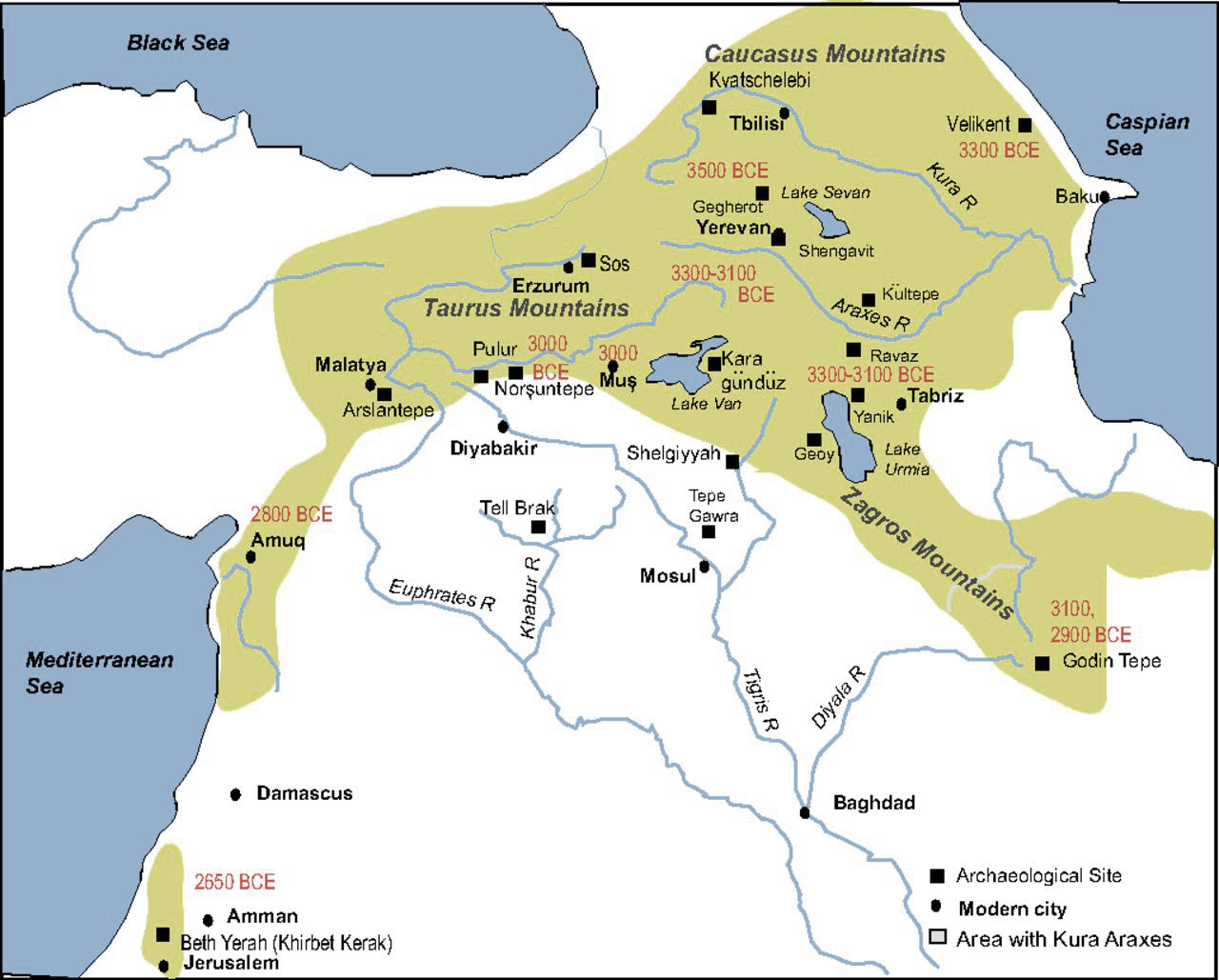
Of course the Nile dwellers did have their own boat building traditions which is why it is important to differentiate the various types seen in the Petroglyphs, the longship tradition was not theirs, frond/reed boats were.
a reply to: Spider879
There are lots of assumptions involved there, why on Earth would anyone want to be in contact with a bunch of farmers in Sudan even if they did have chiefs and elders in their stratified society, like everybody else in the world, and were's this evidence for Levantine contact...?
What is required is an awareness of were and how mineral and ore resources can be acquired and utilized, that's what formed the basis for early trading networks, not farming, and Naqada I culture shows no evidence for such activities, once these are established through contact with a culture that had expertise in such it then becomes a case of what local resources can we exploit and can we expand our area of interest and produce trade goods of our own.
Anatolia had a great tradition in ship building, the first Neolithic expansion into and across the entire Mediterranean and beyond started from there, Greek culture had it's origins in Anatolia and they knew a thing or two about ship building as well as the Minoans, the only surprise here is that doesn't appear to have been the general direction from which Egyptian civilization received it's impetus to develop.
So apart from the fact that they weren't Turks either that's not the region i've been considering , the culture in question originated in the Trans-Caucasus, on the map Gobustan is close to Baku on the Caspian sea, and the ship petroglyphs there date to Mesolithic Period (12,000 - 7,000 BCE), ridiculously old longships.

Of course the Nile dwellers did have their own boat building traditions which is why it is important to differentiate the various types seen in the Petroglyphs, the longship tradition was not theirs, frond/reed boats were.
a reply to: Spider879
There are lots of assumptions involved there, why on Earth would anyone want to be in contact with a bunch of farmers in Sudan even if they did have chiefs and elders in their stratified society, like everybody else in the world, and were's this evidence for Levantine contact...?
What is required is an awareness of were and how mineral and ore resources can be acquired and utilized, that's what formed the basis for early trading networks, not farming, and Naqada I culture shows no evidence for such activities, once these are established through contact with a culture that had expertise in such it then becomes a case of what local resources can we exploit and can we expand our area of interest and produce trade goods of our own.
edit on Kam13127vAmerica/ChicagoSaturday2831 by Kantzveldt because: (no reason given)
originally posted by: Kantzveldt
a reply to: Byrd
Anatolia had a great tradition in ship building, the first Neolithic expansion into and across the entire Mediterranean and beyond started from there, Greek culture had it's origins in Anatolia
No argument there - however Greek culture is not that old, relatively speaking. The earliest Greek civilization (Mycenaeans) dates to around 1600 BC.
and they knew a thing or two about ship building as well as the Minoans, the only surprise here is that doesn't appear to have been the general direction from which Egyptian civilization received it's impetus to develop.
Both of those appear long after Egyptian civilization and long after Egypt had boats.
[qote]So apart from the fact that they weren't Turks either that's not the region i've been considering , the culture in question originated in the Trans-Caucasus, on the map Gobustan is close to Baku on the Caspian sea, and the ship petroglyphs there date to Mesolithic Period (12,000 - 7,000 BCE), ridiculously old longships.
The petroglyphs are a variety of ages. There's a Roman inscription there that is accounted among the petroglyphs and I can assure you that it's not 12,000 years old. The oldest boat images, according to your link, are of two-to-six person boats... not of longships.
Of course the Nile dwellers did have their own boat building traditions which is why it is important to differentiate the various types seen in the Petroglyphs, the longship tradition was not theirs, frond/reed boats were.
a reply to: Spider879
There are lots of assumptions involved there, why on Earth would anyone want to be in contact with a bunch of farmers in Sudan even if they did have chiefs and elders in their stratified society, like everybody else in the world, and were's this evidence for Levantine contact...?
Spider is correct - there's excellent evidence for Saharan involvement, and he linked some of the key pieces of evidence.
[qote]What is required is an awareness of were and how mineral and ore resources can be acquired and utilized, that's what formed the basis for early trading networks, not farming, and Naqada I culture shows no evidence for such activities,
Here is where we disagree on the material. Naqada culture lived along the river and had a need for large transport vessels. There is no reason to believe they were so backwards or stupid as to not envision large boats or to find a way to construct those large boats out of reeds.
BTW, I believe that the only way to make a large reed boat float well is to pull both the prow and the stern upwards out of the water.
once these are established through contact with a culture that had expertise in such it then becomes a case of what local resources can we exploit and can we expand our area of interest and produce trade goods of our own.
Evidence does not suggest that the Egyptians were sitting around, tending fires, and waiting for others to drop out of the sky with trade goods. They were active traders - in fact, in order to have trade up and down the Nile they needed to develop large boats.
...unlike the Caucasus, where there was no absolute necessity for boats (they could still hunt inland.)
a reply to: Kantzveldt
HEY! Those petroglyphs has nothing to do with norsemen, just so you know. They are CELTIC, like the Hjortspring båt. They had a habit of invading Scandinavia and we had a habit of killing them and sacrificing them in bogs.
Either they drew graffiti here or we drew images of them after victory. But either way, if there is european connection to Egypt, it's not to Scandinavia, but to the celts.
HEY! Those petroglyphs has nothing to do with norsemen, just so you know. They are CELTIC, like the Hjortspring båt. They had a habit of invading Scandinavia and we had a habit of killing them and sacrificing them in bogs.
Either they drew graffiti here or we drew images of them after victory. But either way, if there is european connection to Egypt, it's not to Scandinavia, but to the celts.
new topics
-
4 plans of US elites to defeat Russia
New World Order: 1 hours ago -
Thousands Of Young Ukrainian Men Trying To Flee The Country To Avoid Conscription And The War
Other Current Events: 4 hours ago -
12 jurors selected in Trump criminal trial
US Political Madness: 7 hours ago -
Iran launches Retalliation Strike 4.18.24
World War Three: 7 hours ago -
Israeli Missile Strikes in Iran, Explosions in Syria + Iraq
World War Three: 8 hours ago
top topics
-
George Knapp AMA on DI
Area 51 and other Facilities: 13 hours ago, 25 flags -
Israeli Missile Strikes in Iran, Explosions in Syria + Iraq
World War Three: 8 hours ago, 16 flags -
Louisiana Lawmakers Seek to Limit Public Access to Government Records
Political Issues: 16 hours ago, 7 flags -
Iran launches Retalliation Strike 4.18.24
World War Three: 7 hours ago, 6 flags -
Not Aliens but a Nazi Occult Inspired and then Science Rendered Design.
Aliens and UFOs: 13 hours ago, 5 flags -
12 jurors selected in Trump criminal trial
US Political Madness: 7 hours ago, 4 flags -
Thousands Of Young Ukrainian Men Trying To Flee The Country To Avoid Conscription And The War
Other Current Events: 4 hours ago, 4 flags -
The Tories may be wiped out after the Election - Serves them Right
Regional Politics: 17 hours ago, 3 flags -
4 plans of US elites to defeat Russia
New World Order: 1 hours ago, 2 flags
active topics
-
Fossils in Greece Suggest Human Ancestors Evolved in Europe, Not Africa
Origins and Creationism • 62 • : whereislogic -
-@TH3WH17ERABB17- -Q- ---TIME TO SHOW THE WORLD--- -Part- --44--
Dissecting Disinformation • 538 • : cherokeetroy -
4 plans of US elites to defeat Russia
New World Order • 6 • : andy06shake -
So I saw about 30 UFOs in formation last night.
Aliens and UFOs • 24 • : TheMisguidedAngel -
Silent Moments --In Memory of Beloved Member TDDA
Short Stories • 44 • : Encia22 -
Mandela Effect - It Happened to Me!
The Gray Area • 110 • : BeTheGoddess2 -
Vogt and the twelve thousand year cycle
Fragile Earth • 27 • : Lanogaxeh -
12 jurors selected in Trump criminal trial
US Political Madness • 22 • : Disgusted123 -
British TV Presenter Refuses To Use Guest's Preferred Pronouns
Education and Media • 65 • : nugget1 -
Running Through Idiot Protestors Who Block The Road
Rant • 110 • : FlyersFan
